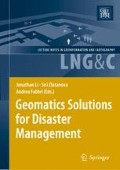Abstract
Differential SAR Interferometry (D-InSAR) technique has been used to monitor the land subsidence evolution in Xi’an, China during the period of 1992 to 2005. Three schemes have been made to detect the three subsidence stages, namely, stage I 1992–1993, stage II 1996–1997 and stage III 2004–2005. And annual subsidence rates have been calculated in three schemes which uncovered the land subsidence evolution in Xi’an from 1990s to now days. The D-InSAR results show that the maximum subsidence rate was up to 20m/a in the 1996, and decreased greatly from 20cm/a in 1996 to 5cm/a in 2005, which mainly owing to the controlling of underground water withdrawal policy in 1996s. For the lack of traditional monitoring results, only the first stage of D-InSAR result has been compared with leveling result, which demonstrated high consistence each other.
Access this chapter
Tax calculation will be finalised at checkout
Purchases are for personal use only
Preview
Unable to display preview. Download preview PDF.
References
Atlantis Scientific (2003) EV-InSAR version 3.0. User’s Guide. Atlantis Scientific Inc. Ontario, 257 pp
Chen CW, Zebker HA (2001) Two-dimensional phase unwrapping with use of statistical odels for cost functions in nonlinear optimization. Journal of the Optical Society of America, 18(2): 338–351
Li T, Liu J, Liao M. (2004) Monitoring City Subsidence by D-InSAR in Tianjin Area. In: IEEE IGARSS2004 Proceedings, Anchorage Alaska, pp. 3333–3336
Liu GX, Ding XL (2001) Settlement field of Chek Lap Kok airport, Hong Kong, detected by satellite synthetic aperture radar interferometry. Chinese Science Bulletin. 46:1778–1782
Lu Z, Patrick M, Fielding EJ, Trautwein C (2003) Lava volume from the 1997 eruption of Okmok volcano, Alaska, estimated from spaceborne and airborne interferometric synthetic aperture radar. IEEE Transactions on Geoscience and Remote Sensing, 41: 1428–1436
Massonnet D, Feigl KL (1998) Radar interferometry and its application to changes in the Earth’s surface. Reviews of Geophysics, 36: 441–500
Massonnet D, Rossi M, Carmona C, et al. (1993) The displacement field of the Landers earthquake mapped by radar interferometry. Nature 364:138–142
Raucoules D, Maisons C, Carnec C, Le Mouelic S, King, C, Hosford S (2003) Monitoring of slow ground deformation by ERS radar interferometry on the Vauvert salt mine (France): comparison with ground-based measurement. Remote Sensing of Environment, 4, 468–478
Scharroo R, Visser PNAM, Mets GJ (1998) Precise orbit determination and gravity field improvement for ERS satellites. Journal of Geophysical Research, 103: 8113–8127
Xia Y, Michel GW (2003) Seismic unloading and loading in northern central Chile as observed by differential Synthetic Aperture Radar Interferometry (DInSAR) and GPS. International Journal of Remote Sensing, 24: 4375–4391
Yan W (1998) Analysis on the Origin of Land Subsidence and Its Countermeasures of Control in Xi’an (in Chinese). The Chinese Journal of Geological Hazard and Control. 119: 27–32
Zebker H, Villaseno J (1992) Decorrelation in interferometric radar echoes. IEEE Transactions on Geoscience and Remote Sensing, 30: 950–959
Zebker H, Rosen P, Goldstein R, Gabriel A, and Werner C (1994) On the derivation of coseismic displacement fields using differential radar interferometry: the Landers earthquake. Journal of Geophysical Research, 99: 19617–19634
Zhu Y, Wang Q (2005) A Study of the Space-Time Change Characteristics of Ground Subsidence in Xi’an and Their Mechanism (in Chinese). Acta Geoscientica Sinica, 26: 67–70
Author information
Authors and Affiliations
Editor information
Editors and Affiliations
Rights and permissions
Copyright information
© 2007 Springer-Verlag Berlin Heidelberg
About this chapter
Cite this chapter
Zhang, Q., Zhao, C., Ding, X., Peng, J. (2007). Monitoring Xi’an Land Subsidence Evolution by Differential SAR Interferometry. In: Li, J., Zlatanova, S., Fabbri, A.G. (eds) Geomatics Solutions for Disaster Management. Lecture Notes in Geoinformation and Cartography. Springer, Berlin, Heidelberg. https://doi.org/10.1007/978-3-540-72108-6_7
Download citation
DOI: https://doi.org/10.1007/978-3-540-72108-6_7
Publisher Name: Springer, Berlin, Heidelberg
Print ISBN: 978-3-540-72106-2
Online ISBN: 978-3-540-72108-6
eBook Packages: Earth and Environmental ScienceEarth and Environmental Science (R0)

